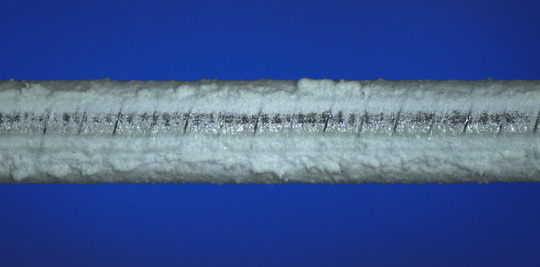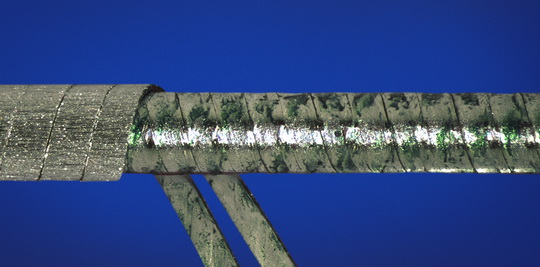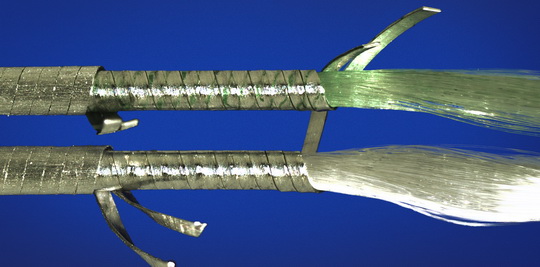Bowed instrument strings need to be cleaned from time to time in order to maintain their best performance. The entire string length should be cleaned of perspiration in order to prevent corrosion. Rosin build up in the bowed area should also be removed. An article about corrosion prevention will be published soon. Let's see first how to deal with rosin build up.

A string covered by a common rosin build up.
Regular cleaning to prevent rosin build up is important to keep your strings sounding and responding well for longer. Rosin should be applied to the bow hair not to the string. Various cleaning method recommendations have been published and some of them can affect the string performance or its durability.
Cleaning with liquid solvents:
Although this is a very quick and easy way to remove rosin we cannot recommend it. The construction of wound strings cannot be completely sealed. The winding has to be open in order to allow the string vibrate freely. By observing the vibrating mode discovered by Hermann von Helmholtz, you will see that the bowed string does not vibrate only in the lens shape which can be seen by the eye. There is quite a sharp edge running back and forth with every oscillation. The string construction has to be able to allow the string to bend suddenly without absorbing too much energy.
A string's construction is quite complex and it gets affected by penetration all kinds of contaminants during its life time. The less the better of course. The typical pollutants in the fingerboard area are perspiration, salt and all kinds of dirt, dust and skin debris. In the bowing area the biggest risk is penetration by thinned rosin when using solvent cleaners.

We have cleaned the rosin build-up just once with alcohol coloured green. In the picture you can see how deeply the solution soaks in.

Comparison of the polluted string with a clean string. Just this one single cleaning action sees the thinned rosin penetrate not only between the two winding layers but also into the entire fibre core. Cleaning strings with alcohol is possible but we do not recommend this method if you want to maintain your string's sound quality for as long as possible.


Comparison of the common synthetic core with W-core used in Amber line. W-core is hydrophobic and therefore not affected by the pollution so deeply. When using the Amber line you pay not only for the ultimate sound quality, but also improved performance and durability. In spite of this, we do not recommend cleaning with alcohol.
Steel wool.
Some people suggest cleaning strings using the finest grade steel wool. We have rubbed this violin string with .000 steel wool for one minute. For a single clean a few seconds may be enough, but one minute of cleaning time can be accumulated over a short period of time. The steel wool has removed 10 – 15 microns (0,010 – 0,015 mm) of the string's mass. If we were to reduce the entire string length in such way, the tension of this violin string would decrease by about 1 – 1.5 Newton, which equals about 0.1 to 0.15 kg difference. It isn't very much, but if the reduction is in just one spot the string can become unstable and out of tune.

Not only that; cleaning with steel wool changes the surface structure a lot. It opens the winding gaps further and polishes the string winding to a perfectly shiny surface. This affects both the playability and the response. In the picture you can see the changed surface structure of the string that has been polished with steel wool.

A violin string covered by a typical amount of fresh rosin build-up. You can see that the rosin does not form regularly around the whole string. There are two ridges resembling snowdrifts surrounding the bow contact line on both sides. The contact line stays relatively clean.

The fresh rosin build up can be removed completely with a microfiber cloth quite easily. If the strings are cleaned daily then no other care should be needed.

Neglected cleaning care. You can see that even the contact line has been covered with fused rosin (particularly on the right side of the picture).

The same string wiped with a cloth. About 90% of the build-up has been removed quite easily. Some of the fused rosin has not been removed by microfiber cloth. You can see the brown mark on the strings. Some of the fibres from the cloth have become stuck to the fused rosin build up.

The same string cleaned with a credit card edge few times afterwards. The card should be slanted slightly to left and right in order to reach the two remnant lines. The removed rosin crust lies loosely on the string's surface.

The same string after just one microfiber cloth wipe. It is absolutely clean without any damage from internal pollution or damage caused by wiping.
Dry wiping has been rejected by some players because it can make an unpleasant noise. However it seems to be the best string cleaning method that doesn't harm the string. Most of the rosin build-up can be removed with a cloth though we do not recommend using excessive force. Using too much pressure can lead to friction which increases the temperature causing the rosin dust to melt and then fuse to the string. This build-up then becomes much more resistant to removal.
The remainder of the rosin build-up should be scratched away gently using a scraper edge. The material of the scraper should be harder than the rosin build-up but softer than aluminium. A credit card or other plastic card makes an ideal tool. The cooler the string at the time of scraping the better. This is why we recommend waiting for about 20 seconds after you have wiped the string with a cloth.
Rosin build-up can also be reduced by using good quality rosin (rosin test results). Use it sparingly and more often. Too much rosin on the bow hair creates rosin build-up very quickly.
